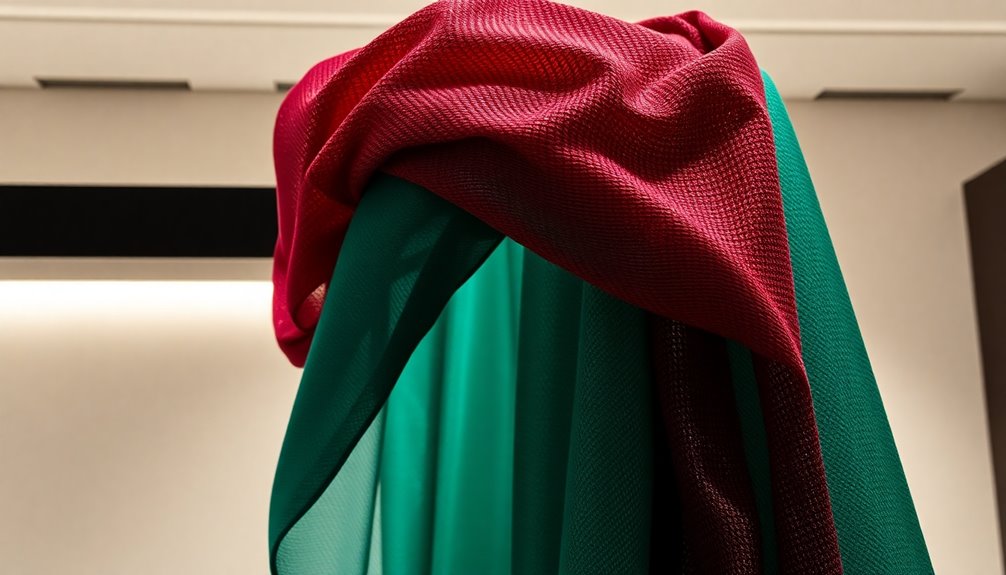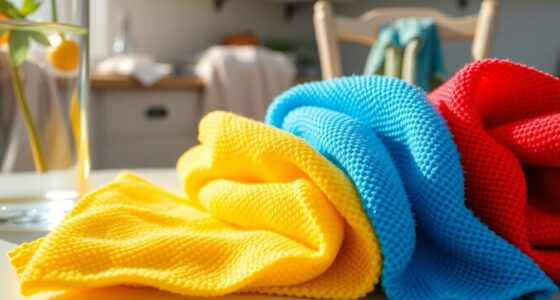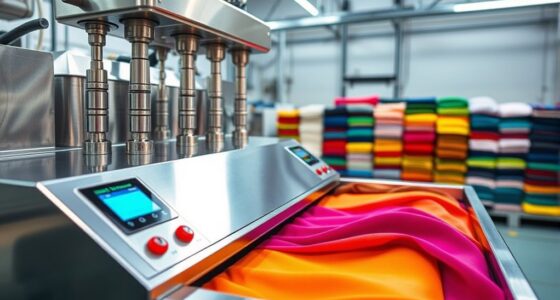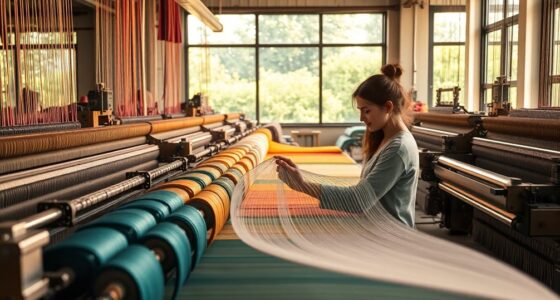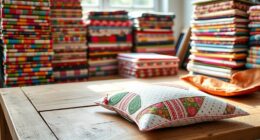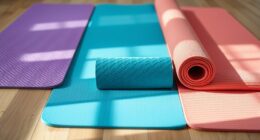Expect a vibrant blend of sustainability and luxury in fabric trends for 2025. You'll see a rise in eco-friendly materials like organic cotton and Tencel, combined with rich textures like velvet and suede that elevate everyday wear. Maximalism will reign in both fashion and interiors, with bold patterns and colors. Performance textiles emphasizing wellness and health features will also emerge. Curious about how these trends will shape your wardrobe and home? There's more to discover!
Key Takeaways
- Expect a significant rise in the use of natural and biodegradable fibers, emphasizing eco-friendly materials like organic cotton, bamboo, and hemp.
- The integration of advanced technologies in textiles will enhance performance features, focusing on health and wellness benefits for consumers.
- Circular economy practices will become mainstream, promoting clothing reuse and recyclable materials to minimize waste in the fashion industry.
- Luxurious textures and earthy color palettes will dominate, with high-end brands prioritizing craftsmanship and eco-responsibility in their designs.
- Gen Z will continue to influence trends, driving demand for custom textiles that align with sustainability and personal wellness goals.
Sustainable Fabric Innovations
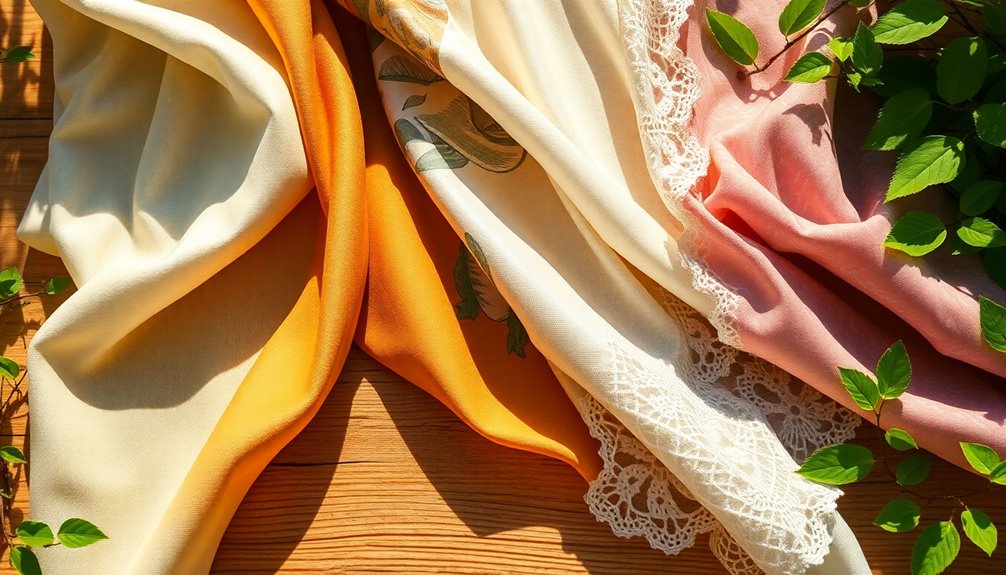
As the fashion industry increasingly embraces eco-conscious practices, sustainable fabric innovations are transforming how we think about materials. You'll notice natural fibers, like ethical wool and cruelty-free silk, are making a comeback, along with organic cotton that prioritizes eco-friendly production. Bamboo and hemp are also gaining traction for their sustainability and biodegradability. Tencel, derived from sustainable wood, offers a circular solution, while agroecological cotton benefits from sustainable agricultural methods. The shift toward circular fashion is evident as brands optimize textile recycling, developing fully recyclable and biodegradable options. With closed-loop systems in place, waste is minimized and resources are reused. Furthermore, the rise of Oeko-Tex certification ensures that these materials are free from harmful substances, promoting a healthier fashion experience. These innovative materials not only benefit the planet but also elevate the fashion experience for consumers like you. Additionally, the use of sustainable fabrics aligns with essential oils for aromatherapy that can enhance the overall sensory experience in fashion, making it more holistic and mindful.
Luxurious Textures for Everyday Wear

The rise of sustainable fabric innovations has set the stage for luxurious textures to become a staple in everyday wear. Earthy neutrals like taupe and olive pair beautifully with ribbed knits, soft suede, and structured denim, adding depth to your outfits. High-end brands are prioritizing eco-friendly materials, merging luxury with environmental responsibility. Emphasizing craftsmanship, they highlight refined details that let your individuality shine without flashy logos. This commitment to sustainability in luxury ensures that designs are not only beautiful but also ethically produced. Imagine styling a soft suede jacket with structured denim or layering ribbed knits for visual interest. Don't forget to accessorize with statement pieces that elevate your look.
Maximalism in Interior Design
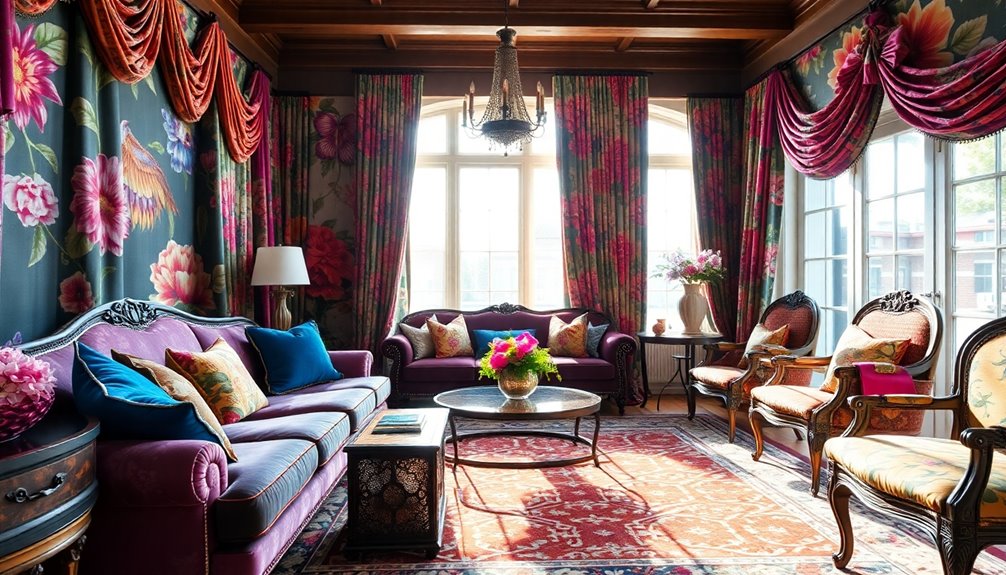
Maximalism in interior design invites you to embrace a world of abundance and creativity, where bold colors and intricate patterns reign supreme. This trend celebrates excess, allowing you to mix rich textiles, eclectic furniture, and layered textures that create a visually striking environment. Choose luxurious upholstery fabrics like velvet and boucle for a cozy yet sophisticated feel. Don't shy away from combining geometric designs and oversized florals; they'll add depth and character to your spaces. Incorporate statement pieces and mixed metals to enhance visual appeal. As you explore maximalism, remember that customization is key—design unique elements that reflect your style while ensuring functionality. Additionally, deep greens are emerging as neutral staples that can beautifully complement the vibrant palette of maximalism. To enhance your space further, consider incorporating educational toys that stimulate cognitive growth and creativity, making your home not just visually appealing but also a hub for learning. Immerse yourself in this vibrant aesthetic and transform your home into a dynamic masterpiece.
Biophilic Design Elements
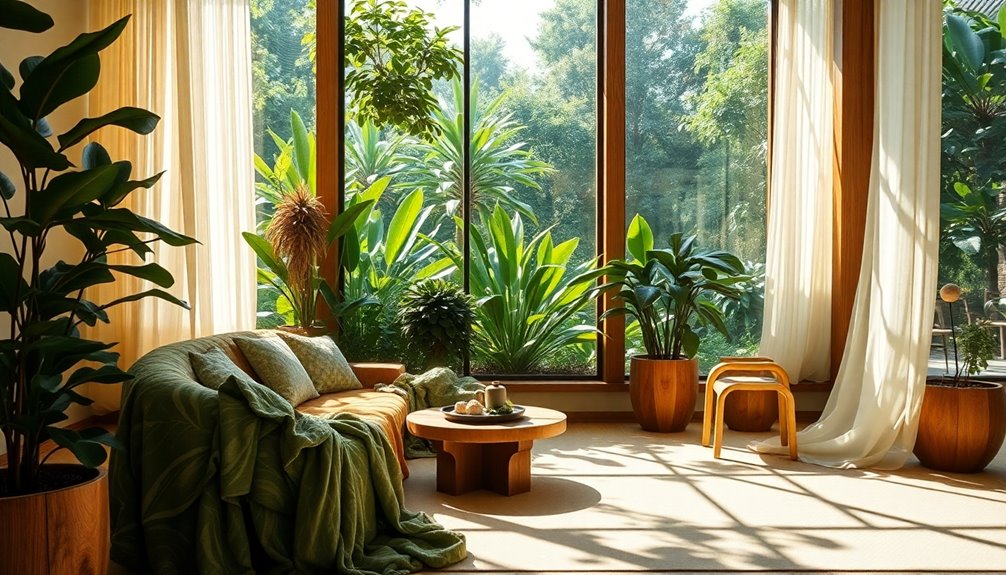
Embracing biophilic design elements can transform your space into a serene sanctuary that fosters a deep connection to nature. Incorporate green walls and vertical gardens for improved air quality and a touch of greenery. Maximize natural light and ventilation to enhance your mood and reduce energy costs. Consider adding calming water features like fountains or ponds to create a tranquil atmosphere. Use organic shapes and nature-inspired color palettes, featuring earthy tones, to bring warmth and balance. Additionally, integrating hydroponic technology can enhance the viability of your green walls, ensuring they thrive while contributing to a sustainable environment. Opt for locally sourced materials and certified wood to celebrate sustainability and authenticity.
Bold Patterns and Graphics
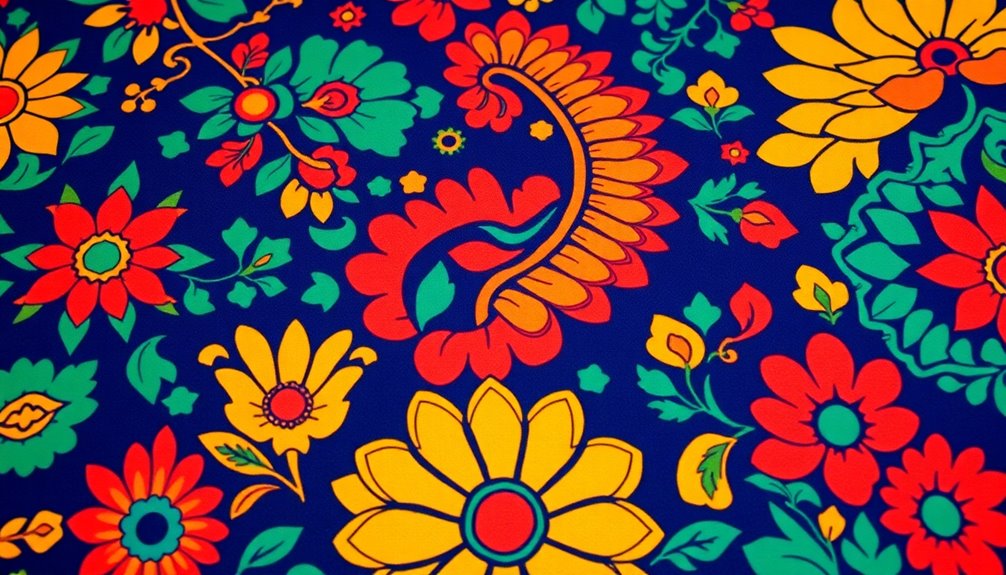
While biophilic design brings a calming connection to nature, bold patterns and graphics inject energy and personality into your space. Influenced by the 2024/2025 collections from renowned designers, these patterns feature striking leaf motifs, geometric shapes, and oversized details that demand attention. Over-scaled details create a unique visual rhythm that enhances the overall impact of the designs. The use of natural materials in these patterns can further enhance the aesthetic appeal, creating a harmonious blend with the surrounding environment.
You'll love how the dynamic prints and tonal variations add sophistication to your wardrobe, making garments true statement pieces. Layered patterns combine vintage charm with modern aesthetics, using rich, jewel tones for an immersive experience.
Embrace vibrant tones and color-drenching techniques that blend patterns with a fresh palette. These designs not only reflect your individuality but also create emotional connections, transforming any space into a vibrant expression of who you are.
Eco-Friendly Fashion Trends
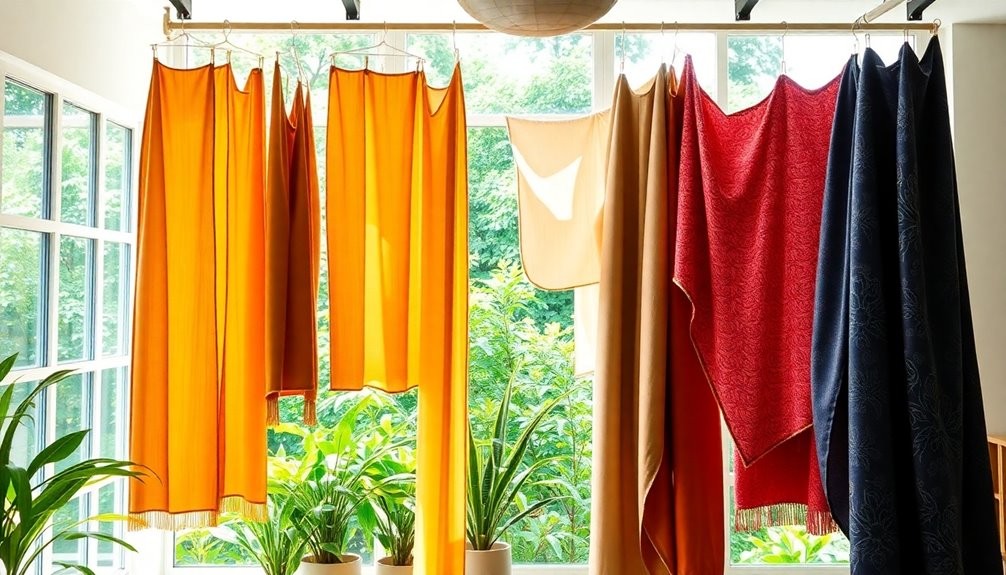
As the fashion industry evolves, eco-friendly trends are taking center stage, reshaping how you think about style and sustainability.
Sustainable materials like bio-fabrication and recycled fabrics are becoming mainstream, allowing you to wear garments that minimize waste. You'll find biodegradable options like Bananatex and innovative plant-based textiles from gin and beer byproducts, contributing to a greener wardrobe. Sustainability is becoming a core principle in the fashion industry, with brands now focusing on circular economy models, promoting the reuse of clothing and ethical labor practices. Many brands are also committed to reducing carbon footprint, which further enhances their sustainability efforts.
Vintage and second-hand finds are gaining popularity, driven by a desire for uniqueness and reduced environmental impact.
With an increasing demand for sustainability, supporting brands that prioritize eco-friendliness is essential, ensuring you make a responsible fashion choice while looking stylish.
Versatile Fabrics for Multiple Settings

Versatile fabrics are transforming how you approach design across various settings, blending functionality with style.
Layered textures like velvet, chenille, and boucle bring a luxurious feel to your living spaces, creating cozy yet sophisticated atmospheres. The interplay of these textures adds dimension, helping unify bold color palettes or contrasting patterns for a dynamic environment. Thoughtful use of textiles can unify bold color palettes and patterns, enhancing the overall visual appeal.
These fabrics are perfect for crafting unique upholstery that reflects your personal style while enhancing multi-functional furniture. Imagine custom pieces with hidden storage or modular configurations that align perfectly with your vision.
By choosing versatile fabrics, you elevate both the aesthetic and practical aspects of your home, making every space inviting and visually interesting.
Embrace versatility to create settings that resonate with your lifestyle.
The Rise of Performance Textiles
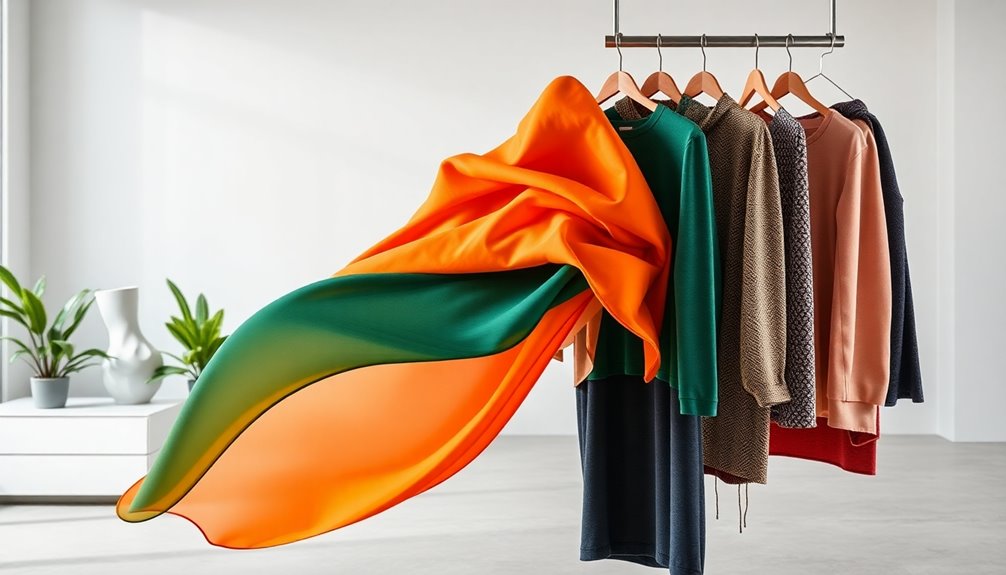
The growing popularity of versatile fabrics sets the stage for the rise of performance textiles, which combine innovation with practicality.
In 2025, you can expect these textiles to focus on sustainability, using eco-friendly materials like organic cotton and bio-based polymers. Sustainable textiles are becoming increasingly important as consumers prioritize environmentally friendly options in their purchasing decisions. Additionally, many of these materials will be enhanced with herbal extracts known for their rejuvenating properties, promoting overall health and vitality in the wearer.
Advanced technologies, including AI and nanotechnology, will enhance manufacturing efficiency while integrating health and wellness features, such as real-time essential sign monitoring.
As consumer demand shifts toward premium quality and aesthetics, the industry will adopt circular economy practices, prioritizing recyclable and compostable materials.
The influence of Gen Z and the slow fashion movement will further drive the need for custom, high-performance textiles that align with your wellness goals and eco-conscious values.
Frequently Asked Questions
How Can I Identify Sustainable Fabrics While Shopping?
When you're shopping for sustainable fabrics, look for labels that indicate certifications like GOTS or Oeko-Tex.
Check the fabric composition for natural fibers such as organic cotton or hemp.
Pay attention to the texture; sustainable options often feel different.
Don't forget to research the brand's practices for transparency.
Finally, be mindful of the price—higher costs can reflect more ethical production methods.
This way, you can make informed choices for the environment.
What Are the Best Care Practices for Luxurious Fabrics?
Did you know that handwashing can extend the life of your luxury fabrics by up to 50%?
To care for these delicate materials, always use cold water and mild, eco-friendly detergents. Gently agitate while washing to avoid stress on fibers, and never machine wash.
When storing, use breathable containers and keep them out of direct sunlight. Regularly inspect for wear, and follow specific care tips for silk, cashmere, and other luxurious fabrics.
How Do I Incorporate Maximalism Without Overwhelming a Space?
To incorporate maximalism without overwhelming your space, start with a neutral base to ground your vibrant elements.
Use bold statement pieces as focal points but balance them with layered textures and calming accents like plants.
Mix patterns carefully, focusing on a cohesive color palette.
Opt for softer, organic shapes in furniture to create flow.
Finally, curate personal collections to add personality without cluttering the area.
This way, you achieve a dynamic yet harmonious environment.
What Are the Benefits of Using Recycled Polyester in Fashion?
Using recycled polyester in fashion offers several benefits.
You're helping reduce plastic waste and conserve energy, as it requires considerably less energy to produce compared to virgin polyester.
This material generates fewer carbon emissions and promotes a circular economy by reusing materials.
Plus, recycled polyester maintains quality, durability, and breathability, making it ideal for various applications.
Embracing this sustainable option lets you contribute to environmental responsibility while enjoying stylish, high-quality products.
Are There Any Disadvantages to Performance Fabrics?
Yes, there are disadvantages to performance fabrics.
You might find them stiffer and less comfortable than natural fibers, which can affect your experience wearing them. They can also be prone to static and may collect pet hair, making maintenance a hassle.
Additionally, some treatments can alter their color, leading to inconsistencies.
If you're considering using them, be aware that they may not suit all applications or aesthetics you desire.
Conclusion
As you look ahead to 2025, keep an eye on sustainable fabric innovations that are shaping the fashion landscape. Did you know that 67% of consumers now prioritize eco-friendly materials in their purchases? This shift not only reflects a growing awareness but also fuels the demand for versatile fabrics that blend luxury with sustainability. Embrace bold patterns and textures that elevate your style while contributing to a healthier planet—it's the perfect way to express yourself and make a difference!
